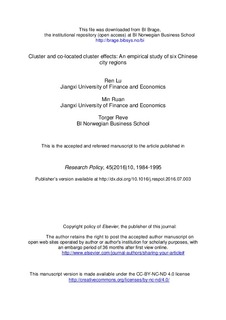| dc.contributor.author | Lu, Ren | |
| dc.contributor.author | Ruan, Min | |
| dc.contributor.author | Reve, Torger | |
| dc.date.accessioned | 2016-11-21T14:12:22Z | |
| dc.date.available | 2016-11-21T14:12:22Z | |
| dc.date.issued | 2016 | |
| dc.identifier.citation | Research Policy, 45(2016)10, 1984-1995 | nb_NO |
| dc.identifier.issn | 0048-7333 | |
| dc.identifier.issn | 1873-7625 | |
| dc.identifier.uri | http://hdl.handle.net/11250/2422201 | |
| dc.description | This is the accepted and refereed manuscript to the article | nb_NO |
| dc.description.abstract | We study how industrial clusters in three different life phases both influence and moderate total
factor productivity (TFP) of other co-located industries or clusters. A multilevel regression model
is applied to panel data, 1993–2012, from the Pearl River Delta, China. Our empirical results show
that emerging clusters have negative effects on other co-located industries’ or clusters’ TFP while
mature clusters have positive effects. Emerging clusters positively moderate TFP, while mature
clusters negatively moderate TFP of other co-located industries or clusters; declining clusters only
have direct positive impact on TFP of other co-located industries or clusters. | nb_NO |
| dc.language.iso | eng | nb_NO |
| dc.publisher | Elsevier | nb_NO |
| dc.title | Cluster and co-located cluster effects: An empirical study of six Chinese city regions | nb_NO |
| dc.type | Journal article | nb_NO |
| dc.type | Peer reviewed | nb_NO |
| dc.source.journal | Research Policy | nb_NO |
| dc.identifier.doi | http://dx.doi.org/10.1016/j.respol.2016.07.003 | |
| dc.description.localcode | 2, Forfatterversjon | nb_NO |
